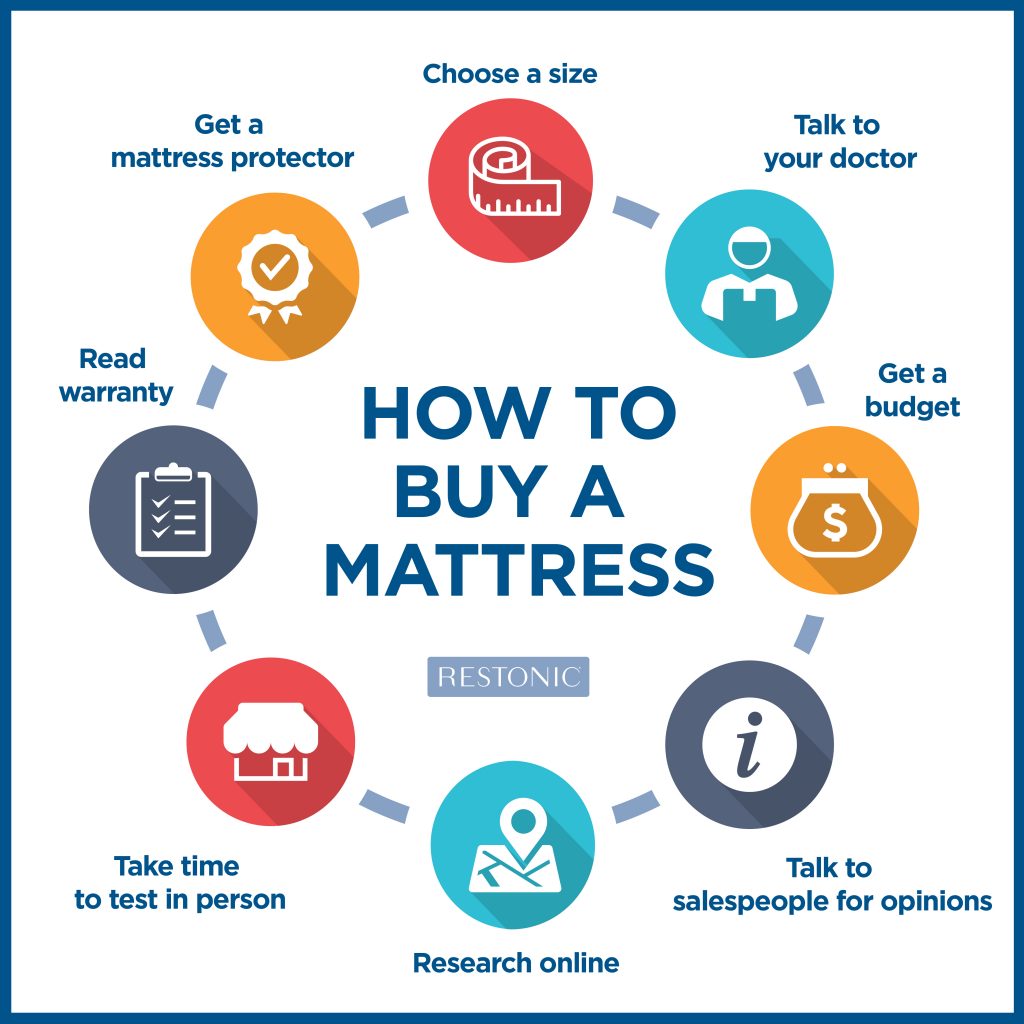What do you “really” know about your mattress?
If you think about it, your mattress is your best friend, there to comfort you in the evening, help you rest throughout the night and greet you as you wake up, refreshed and ready to take on another day. But let’s face it, your BMF (Best Mattress Friend) was probably chosen based on looks (quilt fabric on the top), luxury and price. Mom’s favorite saying, “It’s what’s inside that counts” may not have been top of mind when you bought it.
When it comes to mattresses, your Mom was right – what’s inside your mattress is just as important as the look and feel of it. If your mattress has seen better days, it might be time to go mattress shopping – and to do that you’re going to need to understand what’s inside different types of mattresses.
Mattresses today are built with high-tech components and designed to provide the superior support and comfort your body needs to relax and rest. Relieving pressure points, controlling temperature fluctuations and minimizing partner disturbance are just a few of things your mattress should be working hard at while you sleep.
Understanding what’s inside a mattress begins with learning the lingo
Let’s start with some basic mattress vocabulary you’ll encounter.
- Box spring or foundation. Traditional mattresses sit on these and they can be stationary or an adjustable base. But if you prefer a platform bed, you won’t need any of these as your platform doubles as your foundation.
- Coils. In an innerspring mattress, steel springs provide support when you lie on your mattress. Continuous coils are less expensive than individually pocketed coils – and they excel at making sure you don’t feel movement every time your partner rolls over. The number of coils also varies – the more coils, the higher the price, generally. As well thicker, more supportive coils will also increase the price.
- Foam. There are many different types of foam, including: memory foam, latex and convoluted foam. Each type of foam offers a different comfort proposition so knowing what makes them unique will help you find the right one for you.
- Firmness. Mattress support refers to how well a mattress maintains an equally level surface for the lighter (head, hands and feet) and heavier (hips and torso) pressure points of your body. A very soft mattress may be supportive but fail to maintain equilibrium long term.
- Pillow-top, plush-top or euro-top mattress. Each term refers to the upper comfort level of your mattress. Pillow-top mattresses tend to be thicker and puffier looking while plush top may look and feel firmer. Euro-top mattresses are cushioned like a pillow-top but more tailored in their look.
If you’re curious about more (sometimes confusing) mattress terms, please visit our mattress glossary.
Hybrid mattresses – the newest type of mattress on the market
The more you learn about modern mattress technology, the more you’ll understand that you don’t have to choose between innerspring or foam. The term hybrid mattress refers to the process of combining different components that will result in a similar but more improved product. Think of a hybrid car, powered by a combustion and electric engine. The improved result is less gas and energy efficient – not to mention good for your wallet.
Hybrid mattresses begin with a base coil system (pocketed or innerspring coil) with varying combinations of memory foam, latex and/or gel on top to create more resilient comfort layers. These diverse layers work together to provide significantly improved pressure point relief during sleep, which reduces tossing and turning. The spring base gives the hybrid its bounciness (good for your joints) and contouring support (good for your back). Some mattress experts feel that hybrid mattresses reduce the chance of body impressions because the construction materials support each other in ways we’ve never seen before.
Support, comfort and conformability – putting the mattress magic together!
Your mattress has one job – ensure you get a good night’s sleep. And to do that job, it needs to be supportive to your unique body shape and size. A herculean task if you think about different we all are and how we all see support and comfort so uniquely.
A supportive mattress allows your muscles to relax, which improves healthy blood circulation and reduces tossing and turning – and delivers the promise of a good night’s sleep.
And that’s where conformability comes into play. Conformability describes how a mattress molds to the unique curves of your body. A mattress with good conformability attends to heavier and lighter areas equally, which relieves pressure point pain and protects your back and sensitive joints from pain.
A mattress that lacks conformability forces your body into an unnaturally flat position. Your body is in alignment when your spine is (mostly) straight when lying on your side. When you lie on your back, your spine naturally forms an “S” shape.
By now, you’re probably wondering how anyone can buy a new mattress with all of these different focus points – from what’s inside the mattress to how it affects your body. And that’s where understanding how to shop for a mattress becomes important. Hint: it requires a LOT of testing.
How to shop for a new mattress
In a research study sponsored by Restonic and published in Furniture Today, consumers say they’re plugged into learning about the construction of a mattress during the purchase process. “The best part about shopping is the variety of types, sizes and comfort levels,” said a 39 year-year-old shopper. Of the 750 consumers surveyed, 78% were very concerned with comfort, 65% with firmness/support and 53% with the construction of their mattress. The research also showed 8 out of 10 consumers enjoyed lying on the mattress before purchasing.
 When you visit a mattress store – and we recommend you visit a few before making your final decision – plan to spend time testing out mattresses. Some people like to take their pillow from home so that each mattress they lie is being judged based on the same criteria – not a different pillow on each one. Whether you bring your own pillow or use the store’s pillow, pay attention to how well the mattresses you’re testing conforms to your shape as well.
When you visit a mattress store – and we recommend you visit a few before making your final decision – plan to spend time testing out mattresses. Some people like to take their pillow from home so that each mattress they lie is being judged based on the same criteria – not a different pillow on each one. Whether you bring your own pillow or use the store’s pillow, pay attention to how well the mattresses you’re testing conforms to your shape as well.
You’ll have a better buying experience when you set your own pace and guidelines. The Better Sleep Council uses the acronym S.L.E.E.P. to outline the best way to test a mattress:
- Select a mattress
- Lie down in your typical sleep position
- Evaluated the level of comfort and support
- Educate yourself about each selection
- Partners should test beds together
Instead of focusing on what you should do when you’re shopping for a new mattress, let’s look first and what you shouldn’t do.
Mattress shopping don’ts – a comprehensive list
- Don’t just follow friends & family advice. “Everyone has their opinions on the best or worst mattresses,” says Caitlin Hoff, health and safety investigator, ConsumerSafety.org, “but not everyone is built the same way or even sleeps in the same position.” Consider all the advice but pay more attention to your body type and sleeping habits.
- Don’t let price be your only guide. Supportive, comfortable mattresses made from high-quality, durable materials aren’t cheap. “With an overwhelming number of options on the market, it can be easy to pick a cheap mattress and just move on,” says Hoff. “But remember that you’ll spend roughly one-third of your time sleeping on your mattress. An investment in a supportive mattress that meets your needs is an investment in a decade of restful nights.” That’s something that really is truly priceless.
- Don’t go mattress shopping by yourself. “A huge mistake that people make when mattress shoppingis leaving their partner at home,” explains Hoff. “Just because a mattress is good for one person does not mean it will be good for both.” Go shopping together so you can gauge each other’s reaction to each one you test.
- Don’t skip the mattress testing. Your new mattress will be part of your life for 8-10 years so take time to lie down on it in different sleeping positions. While it may feel awkward to spread out on the display beds with other buyers milling about, a good night’s sleep is well worth any perceived embarrassment. To boost your confidence in your choice of mattress, ask about a possible trial period to test out the mattress. Spending a few nights sleeping on it is the best barometer of its suitability for you.
- Don’t skip the crucial details. “A mattress is a major life purchase,” Hoff points out. “It affects your mental and physical health so if you take home a mattress and find that it does not meet your needs, you should return it.” Most mattress companies will have a trial period when a mattress can be returned, but many also have a “return fee.” Know the return policy before you buy.
- Don’t skimp on doing your homework. Make sure you understand the components that make up your chosen mattress, including density, type of foam and coil count. What’s inside your mattress will the comfort life of your new mattress. Stick to the facts and forget the marketing jargon to help guide you to the perfect mattress for you.
- Don’t underestimate the importance of your personal comfort preference. Somewhere in between firm and soft is your ideal mattress, but most people tend to gravitate toward one end of the spectrum or other. There’s a belief that a firmer mattress is better for your back but that’s not necessarily true. Some mattress with softer pillow tops can ease pain by reducing the amount of pressure of problematic areas.
- Don’t rush. You wouldn’t buy the first car you test drive, right? Spend time researching mattress basics and visit a mattress showroom to kick off your quest for the best mattress. You’ll have a chance to see what your options are and talk to sales reps, who can be a wealth of information. A good sales person will ask you about how your sleep habits, your preferences and the budget you have in mind. Ask plenty of questions and take their advice into consideration.
Rest well & wake up ready to go!
Better sleep gives rise to better mornings, bringing your goals into focus and dreams within reach. Hungry for more sleep info? Dig into these posts:
Eager for more sleep info you can really use?
Join our community
Facebook
and let's continue the conversation.
We'd love to hear what you have to say!
This blog does not provide medical advice. It is intended for general informational purposes only and does not address individual circumstances. It is not a substitute for professional medical advice, diagnosis or treatment and should not be relied on to make decisions about your health. Never ignore professional medical advice in seeking treatment because of something you have read on Restonic.com. If you think you may have a medical emergency, immediately call your doctor or dial 911.

